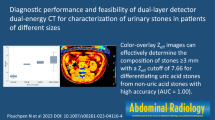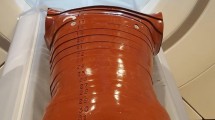Abstract
Purpose
To assess the non-inferiority of dual-layer spectral detector CT (SDCT) compared to dual-source dual-energy CT (dsDECT) in discriminating uric acid (UA) from non-UA stones.
Methods
Fifty-seven extracted urinary calculi were placed in a cylindrical phantom in a water bath and scanned on a SDCT scanner (IQon, Philips Healthcare) and second- and third-generation dsDECT scanners (Somatom Flash and Force, Siemens Healthcare) under matched scan parameters. For SDCT data, conventional images and virtual monoenergetic reconstructions were created. A customized 3D growing region segmentation tool was used to segment each stone on a pixel-by-pixel basis for statistical analysis. Median virtual monoenergetic ratios (VMRs) of 40/200, 62/92, and 62/100 for each stone were recorded. For dsDECT data, dual-energy ratio (DER) for each stone was recorded from vendor-specific postprocessing software (Syngo Via) using the Kidney Stones Application. The clinical reference standard of X-ray diffraction analysis was used to assess non-inferiority. Area under the receiver-operating characteristic curve (AUC) was used to assess diagnostic performance of detecting UA stones.
Results
Six pure UA, 47 pure calcium-based, 1 pure cystine, and 3 mixed struvite stones were scanned. All pure UA stones were correctly separated from non-UA stones using SDCT and dsDECT (AUC = 1). For UA stones, median VMR was 0.95–0.99 and DER 1.00–1.02. For non-UA stones, median VMR was 1.4–4.1 and DER 1.39–1.69.
Conclusion
SDCT spectral reconstructions demonstrate similar performance to those of dsDECT in discriminating UA from non-UA stones in a phantom model.




Similar content being viewed by others
References
Scales CD Jr, Smith AC, Hanley JM, Saigal CS (2012) Prevalence of kidney stones in the United States. Eur Urol 62:160–165
Uribarri J, Oh MS, Carroll HJ (1989) The first kidney stone. Ann Intern Med 111:1006–1009
Morgan MS, Pearle MS (2016) Medical management of renal stones. BMJ (Clinical research ed) 352:i52
Newhouse JH, Prien EL, Amis ES Jr, Dretler SP, Pfister RC (1984) Computed tomographic analysis of urinary calculi. AJR Am J Roentgenol 142:545–548
Motley G, Dalrymple N, Keesling C, Fischer J, Harmon W (2001) Hounsfield unit density in the determination of urinary stone composition. Urology 58:170–173
Graser A, Johnson TR, Bader M, et al. (2008) Dual energy CT characterization of urinary calculi: initial in vitro and clinical experience. Invest Radiol 43:112–119
Boll DT, Patil NA, Paulson EK, et al. (2009) Renal stone assessment with dual-energy multidetector CT and advanced postprocessing techniques: improved characterization of renal stone composition–pilot study. Radiology 250:813–820
Duan X, Li Z, Yu L, et al. (2015) Characterization of urinary stone composition by use of third-generation dual-source dual-energy CT with increased spectral separation. AJR Am J Roentgenol 205:1203–1207
Kulkarni NM, Eisner BH, Pinho DF, et al. (2013) Determination of renal stone composition in phantom and patients using single-source dual-energy computed tomography. J Comput Assist Tomogr 37:37–45
Ananthakrishnan L, Rajiah P, Ahn R, et al. (2017) Spectral detector CT-derived virtual non-contrast images: comparison of attenuation values with unenhanced CT. Abdom Radiol (NY) 42(3):702–709
Blackledge MD, Collins DJ, Koh DM, Leach MO (2016) Rapid development of image analysis research tools: bridging the gap between researcher and clinician with pyOsiriX. Comput Biol Med 69:203–212
McCollough CH, Leng S, Yu L, Fletcher JG (2015) Dual- and multi-energy CT: principles, technical approaches, and clinical applications. Radiology 276:637–653
Lombardo F, Bonatti M, Zamboni GA, et al. (2017) Uric acid versus non-uric acid renal stones: in vivo differentiation with spectral CT. Clin Radiol 72:490–496
Hidas G, Eliahou R, Duvdevani M, et al. (2010) Determination of renal stone composition with dual-energy CT: in vivo analysis and comparison with x-ray diffraction. Radiology 257:394–401
Siener R, Buchholz N, Daudon M, et al. (2016) quality assessment of urinary stone analysis: results of a multicenter study of laboratories in Europe. PloS ONE 11:e0156606
Author information
Authors and Affiliations
Corresponding author
Ethics declarations
Funding
This study received financial support from Philips Healthcare.
Conflict of interest
An institutional research agreement exists between UT Southwestern Medical Center and both Philips Healthcare and Siemens Healthcare. Lakshmi Ananthakrishnan, Xinhui Duan, Yin Xi, Matthew A. Lewis, Margaret S. Pearle, Jodi A. Antonelli, Harold Goerne, Elysha M. Kolitz, Suhny Abbara, Robert E. Lenkinski, Julia R. Fielding, and John R. Leyendecker declare that they have no conflicts of interest.
Ethical approval
All procedures performed in studies involving human participants were in accordance with the ethical standards of the institutional and/or national research committee and with the 1964 Helsinki declaration and its later amendments or comparable ethical standards.
Human and animal rights
This article does not contain any studies with animals performed by any of the authors.
Informed consent
Informed consent was obtained from all individual participants included in the study.
Rights and permissions
About this article
Cite this article
Ananthakrishnan, L., Duan, X., Xi, Y. et al. Dual-layer spectral detector CT: non-inferiority assessment compared to dual-source dual-energy CT in discriminating uric acid from non-uric acid renal stones ex vivo. Abdom Radiol 43, 3075–3081 (2018). https://doi.org/10.1007/s00261-018-1589-x
Published:
Issue Date:
DOI: https://doi.org/10.1007/s00261-018-1589-x




